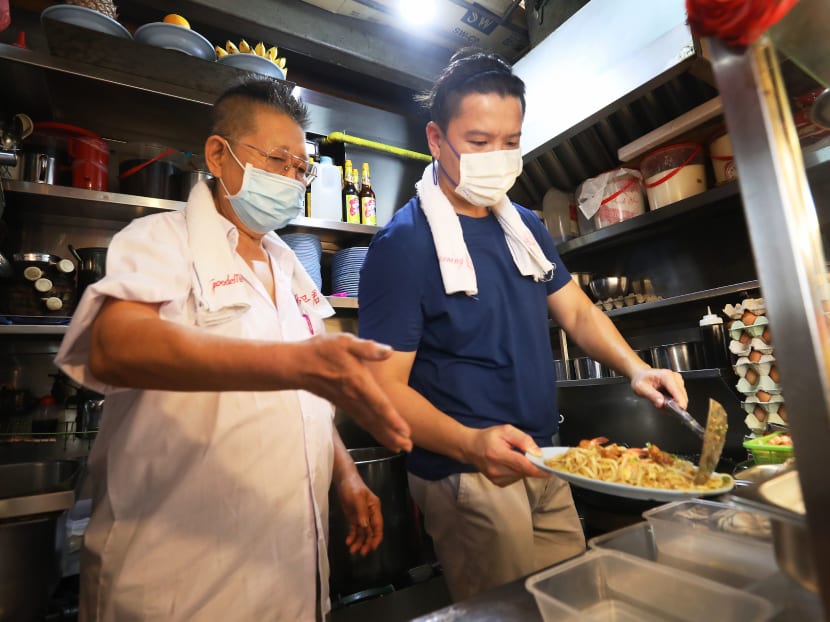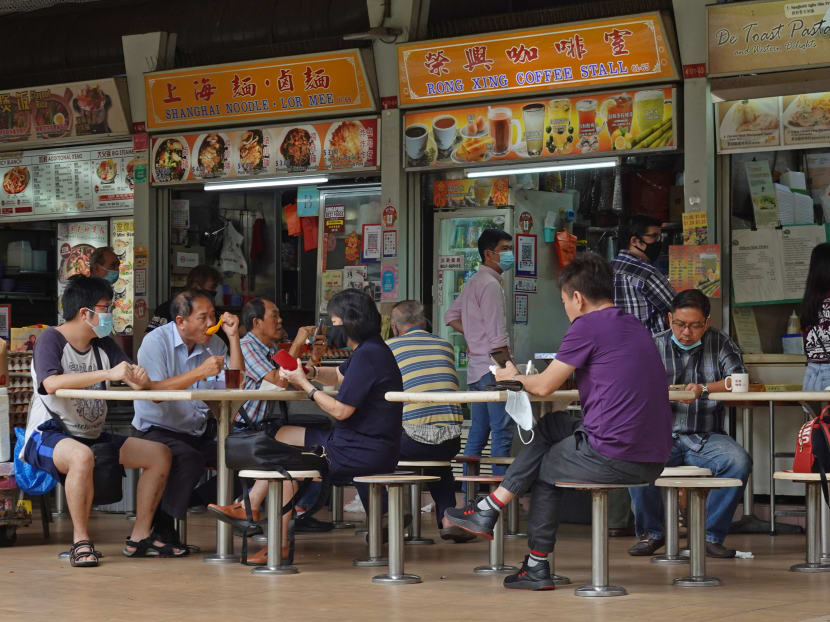Singapore’s hawker culture clinches spot on Unesco’s intangible cultural heritage list
SINGAPORE — After a journey of more than two years, Singapore’s hawker culture has made it onto a prestigious list of international treasures, alongside Indonesia’s angklung musical tradition and South Korea’s kimjang, the making and sharing of kimchi.

Mr Kang Kaiming (left) showing his mentee Louis Wong how to serve Hokkien prawn noodles at Geylang East Market and Food Centre.
- Singapore's hawker culture joins more than 463 items already on Unesco's list of intangible culture heritage
- Hawker centres play a crucial role in enhancing community interactions and strengthening the social fabric, Unesco's evaluation body noted
- PM Lee thanked the generations of hawkers, called on Singaporeans to celebrate by ordering their favourite hawker dish
SINGAPORE — After a journey of more than two years, Singapore’s hawker culture has made it onto a prestigious list of international treasures, alongside Indonesia’s angklung musical tradition and South Korea’s kimjang, the making and sharing of kimchi.
The decision to inscribe hawker culture in Singapore onto the Intangible Cultural Heritage of Humanity list under the United Nations Educational, Scientific and Cultural Organisation (Unesco) was announced by the international body's intergovernmental committee on Wednesday (Dec 16).
This comes five years after Singapore’s successful bid to have the Botanic Gardens listed as a Unesco World Heritage Site.
The nation's hawker culture joins the more than 463 items already inscribed on the list of intangible culture heritage. This is Singapore's first attempt at making this Unesco list.
In a Facebook post, Prime Minister Lee Hsien Loong thanked the people who have "worked very hard" to get Singapore's hawker culture inscribed on the list.
"The biggest thanks must go to the generations of hawkers for nourishing a nation’s stomach and spirits. This recognition would not have come without their sweat, toil and dedication to their profession," Mr Lee said.
He also called on Singaporeans to celebrate by ordering their favourite hawker dish.
Unesco recognises intangible cultural heritage as “living heritage” where traditions and practices are passed from one generation to the next.
Last month, in recommending its inclusion, a 12-member evaluation body noted that hawker culture is integral to Singapore’s way of life and provides a sense of identity and continuity for people across the generations.
It announced its recommendation after deeming that Singapore’s Unesco submission had fulfilled all the criteria required.
On Wednesday, the committee said: "As a social space that immerses people from diverse socioeconomic backgrounds, hawker centres play a crucial role in enhancing community interactions and strengthening the social fabric."
Mr Edwin Tong, Minister for Culture, Community and Youth, hailed this as an "important achievement" because Singapore's hawker culture is a "powerful representation of who we are".
"If you walk into any hawker centre, you'll find different stalls with different food, different sellers serving a myriad of different people from different races, from all walks of life, all seated, side by side, shoulder to shoulder," Mr Tong said.
"And I think that's what it means for us. It means recognition of that culture, our nation's identity, and of course, a shared sense of our heritage and social fabric as well."

Singapore’s bid to make it onto the coveted list began in March 2019, when it made its submission to Unesco.
The organisations involved in the submission — the National Environment Agency, National Heritage Board, and The Federation of Merchants' Associations — highlighted several aspects of hawker culture.
These included hawker centres as community dining spaces, the culinary skills of hawkers, hawker centres as a reflection of Singapore’s multicultural society, and a “thriving culture” in a highly urban environment.
In a recent interview with TODAY, Mr Victor Yue, honorary treasurer of Singapore Heritage Society, said that the Unesco spot will give stakeholders greater impetus to improve the infrastructure and cleanliness of hawker centres.
Indeed, in 2011, Dr Vivian Balakrishnan who was then Minister for Environment and Water Resources announced that 10 new hawker centres were to be built over the next decade, mostly in new housing estates such as Pasir Ris and Punggol.
Food blogger Leslie Tay said that making the Unesco list will also improve the profile of hawkers here, with the Government putting in more resources to upgrade hawker centres and attract more patrons.
One hawker, soya bean stall owner Low Teck Seng, said that the recognition by the international body will also draw tourists to hawker centres once the tourism industry recovers from the Covid-19 pandemic.
Mr Darren Teo, co-owner of fish soup stall Seafood Pirates at Yishun Park Hawker Centre, told TODAY that with Unesco requiring state parties to update the committee on measures they have taken to maintain their intangible heritage every six years, there will be more impetus for the Government to attract new blood to the trade and keep it going.












